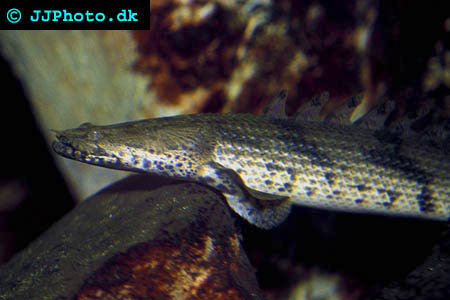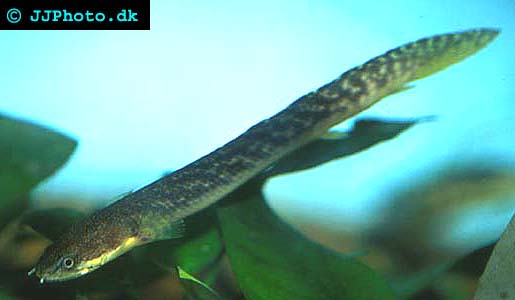The Polypteridae family contains two genera, the genus Erpetoichthys and the genus Polypterus. The genus Erpetoichthys includes only one species; the Erpetoichthys calabaricus fish (commonly known as “Reed Fish” and “Rope Fish”). The genus Polypterus is a rich genus with plenty of species, such as Polypterus delhezi, Polypterus retropinnis, Polypterus weeksii and Polypterus bichir. Polypterus bichir is the type species of the genus Polypterus and was the first scientifically described Polypterus species. Polypterus bichir fish is often referred to simply as “Bichirs”. The species is also commonly known as Nile Bichir, since its native to the River Nile in Africa.
All members of the Polypteridae family share common distinguishing features, such as the snake shaped body. They are also equipped with a remarkable swim bladder that makes it possible for them to use oxygen from the air. These fishes are therefore capable of leaving the water and use their strong pectoral fins to crawl to a new home. This is an adaptation to a life in low oxygen waters in Africa. They are found in lakes as well as rivers in Africa, and if their home dry out during a drought they can move to a new puddle. Their common ancestor developed around 60 million years ago during the Cretaceous era.
As mentioned above, the Polypterus bichir is found in the River Nile and a few other African lakes and river. Its lower jaw is much longer than the upper one. The name Polypterus translates as "many fins" and the Polypterus bichir has 14-18 dorsal spines. The largest caught Polypterus bichir meassured 68 cm (27"). The Polypterus bichir displays a dark grey colour on its dorsal surface and irregular vertical bands on the flanks. Before reaching adulthood, the Polypterus bichir is covered in dark horizontal bands that become paler and paler as the fish grows. The most popular Polypterus species among aquarists today are the Polypterus delhezi, Polypterus palmas, Polypterus ornatipinnis, and Polypterus senegalus. All four of them are oddly enough referred to as Bichirs too.
If you keep small Bichir species, a 120 x 38 cm (48 x 15”) bottomed aquarium is enough. The volume is less significant than the bottom size, since the Bichir is a bottom dweller. Bigger Bichir species will need a bottom measuring at least 180 x 60cm (6 x 2’) to do well. Even though they are bottom dwellers, they must be able to surface when they feel like it. This is because they breed oxygen from the air as well. Always ensure that your Bichir has enough room to go up for a fresh breath of air.
The substrate in the aquarium should be one that is easy to keep fresh and clean, such as silver sand or a thin layer of soft sand. You do not have to decorate the aquarium, but the Bichir will appreciate it if you do. Watching your Bichir will also be much more enjoyable if the fish is kept with robust plants, bogwood, rocks etcetera that allows it to display more natural behaviours. Having several places to hide will also reduce the amount of stress experienced by your Bichir, and will ultimately lead to a more happy and healthy fish.

Polypterus endlicheri endlicheri – A bichir available in the aquarium trade. Copyright www.jjphoto.dk
Your Bichir will appreciate a pH of 7 or slightly below, and the water should also ideally be just a little bit hard. The quality of the water is however always more important to the Bichir than the exact harness and pH-value. Perform frequent water changes to avoid poor water quality. Being a nocturnal fish, your Bichir will typically be sluggish during the day and active during the night. If you install a blue moonlight bulb in the aquarium you will be able to enjoy the natural nightfall behaviour of your Bichir. The Bichir will also appreciate getting a more natural sunset period instead of just a rapid switch to complete darkness.
You can keep your Bichir with non-aggressive species as long as they are too large for the Bichir to swallow. Suitable species include Siamese Tigerfish, Knifefish and large Barbs. You can also keep several Bichirs together. They might fight a little over the food when you feed them, but they will generally tolerate each other very well. All the Bichirs should be of roughly the same size, and you must of course have a large aquarium if you want to keep several Bichirs together. Do not keep your Bichir with suckermouth catfish, since suckermouths are found of sucking on Bichirs which will make the Bichir very stressed and irritated. Also avoid all aggressive species, such as large cichlids and snakeheads.
Since the Bichir is a predatory fish, you should feed it meaty foods. It will accept a large variety of meaty foods, including baitfish, mussels and shrimps. Many Bichirs also “steal” food intended for other inhabitants of the aquarium and will happily eat even algae wafers. Bichirs depend on their keen sense of smell to locate potential food, and will therefore sometimes not notice the food until the food has been in the water for a few moments. Young Bichirs should be fed small pieces of food, such as bloodworms.

Polypterus palmas – A somewhat rare bichir. Copyright www.jjphoto.dk
Didn't find the info you were looking for? Register for free and ask your question in our Aquarium forum !
Our knowledgeable staff usually responds to any question within 24 hours
Related Articles
Alligator Gar - An article about Alligator gars in the wild, and some of the treats to the alligator gar population.
Arapaima fish - An introduction to Arapaima fish, also know as pirarucu
Arowana fish - An article about Arowana fish
Asian Arowana - An article about the asian arowana
Asian Snakehead Fish - An introduction to Asian Snakehead fish
Black piranha - Information about the Black piranha
Breeding Bichirs - Information about Breeding Bichirs
Breeding Piranhas - a short review - a short review
Channa aka frankenfish - Information about Channa aka frankenfish
Channa bleheri / The Rainbow snakehead - Channa bleheri.
Datnoids - Information about Datnoids, also known as dats and siamese tigers
Environmental effects of Snakeheads - Information about the Environmental effects of Snakeheads
Freshwater Moray eels - keeping freshwater Moray eels
Freshwater Pufferfish - Information about different species of freshwater pufferfish
Freshwater Sawfish - An introduction to freshwater swordfish and their present endangered status.
Keeping Gars - Basic Gar keeping information
Keeping Pirhana fish (piranha) in aquarium - Information about Keeping Pirhana fish in aquarium
Keeping Snakeheads in Aquariums - Information about Keeping Snakeheads in Aquariums
Lung fish - Information about Lung fish
Needlefish - An introduction to Needlefish
Nile perch - Information about Nile perch
Payara – Vampire Fish - Information about Payara – Vampire Fish
Piranha keeping - Different species of Pygocentrus and Serrasalmus are commonly kept. Their characteristics, tank and living requirements,
Pirhana - Information about Pirhanas
Porcupine puffer fish - An introduction to Porcupine puffer fish
Pufferfish - An introduction to Pufferfish.
Silver Arowana - An article about Silver Arowana
Snakehead fishing - Information about Snakehead fishing
Snakehead Fish - Information about Snakeheads
Toadfish - An introduction to Toadfish



